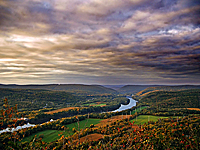Look to the Future, Not the Past

Here is author Dan Goleman's response to Joel Makower's blog post, "Will Radical Transparency Save the Earth?"
Joel, I can see how 20 years of watching the green marketplace would leave you a skeptic about the potential of radical transparency to move the green agenda in a substantial way. But I don’t believe the last 20 years offer apt data points for projecting the next 20. It’s the future I’m talking about, not the past.
The information systems that will bring about radical transparency for ecological impacts are disruptive innovations, advances that change the game in ways the market does not expect.Ecological Intelligenceis a heads up about what’s coming, and how disruptive applications of information systems likeGoodGuidecan trigger an entirely novel green agenda with fresh rules, one where a product’s overall ecological impacts become intrinsic to the value proposition.
Can a mass of shoppers, each making individual decisions based on ecological transparency, bring us to a tipping point where true eco-impacts are routinely weighed into a product’s value? As you point out, the last 20 years suggest not. But remember, I’m not talking about today’s shoppers -- I’m pointing to the tweet-and-text generation, particularly the 13 to 23 year olds who are growing up in constant digital touch with each other. For them individual action merges into the collective, especially with digital data.
But think of the tipping point from another angle: the moment that a shift in market share catches the eye of an alert brand manger, who extrapolates into the future and sees competitive advantage in upgrading that brand’s ecological impacts. Such metrics occur when a system like GoodGuide operates in a well-defined, trackable space -- say, along with Yahoo product searches or a within the aisles of a national retailer -- and market share shifts due to these ratings.
Here the tipping point can be in the low single digits. Take what happened at Maine’s Hannaford supermarkets, when the retailer posted nutritional ratings (done at Yale and Dartmouth) next to the price tag of the items on their shelves. Poorly rated brands dropped as much as 5 percent in sales, with the three-star brands up to 7 percent. Brand managers started contacting Hannaford to ask what they needed to do to get higher ratings.
The more mental and behavioral effort demanded to get info, the higher its cost. At Hannaford the effort cost dropped to zero -- and 4 in 10 shoppers used the ratings to guide their decisions. The forest of green labels for products have all suffered from high cognitive costs: Shoppers cannot tell at a glance how a labeled item compares to others; they may not understand the meaning of the label; they may have to go online and seek it out; they might need to do some computation of their own to use it to compare products.
作为一个有进取心gated database GoodGuide can roll all green labels into a single rating (many green rating systems likeClimateCountsare already part of the system, and more likeGreenSealare sharing their data). If you want the specifics for environmental, health, or social impacts, the system’s transparency lets you dig down. This means death to greenwashing. For example, on GoodGuide products of a national “organic” dairy brand get mediocre ratings because of its inhumane and water-polluting agro-industry feedlot practices.
Retailers are already talking to GoodGuide about putting their ratings next to price tags on store shelves. One day I expect to see GoodGuide ratings pop up when you search for a product by name on Yahoo or Google. Another scenario sees us use such an app with your credit card so it automatically rates what you’ve been buying and routinely sends up better alternatives. Only our imagination limits such digital apps.
Another reason I foresee more people paying attention: GoodGuide incorporates ratings of toxic ingredients into its scores. Discovering which kid’s sunscreen contains a chemical that becomes a carcinogen when exposed to the sun has far greater emotional punch than more remote issues like deforestation, or slow-building ones like global warming. Our brains trigger alarm when threats are personal and in the here-and-now, not at a distant remove.
The scenario depicted in "Ecological Intelligence" goes beyond consumer-facing apps like GoodGuide to how transparency-driven market shifts in turn can create a virtuous cycle, where companies change ingredients, suppliers or industrial platforms (e.g., to green chemistry) to compete on ecological virtues. Another proof-of-concept information system,Earthster, facilitates such upgrades. In this open-source supply chain software companies enter the life cycle assessment data for their products to see where their worst ecological impacts are -- and so where the greatest advantage will be to find an upgrade like bio-based plastics or green chemistry. Suppliers who offer such upgrades can be found there, too.
Imagine in the next decade or so when perpetual ecological upgrades are driven by a single information system that has an Earthster-like face toward manufacturing and a GoodGuide-ish rating for shoppers, both sourcing the same LCA data.
You say, “Likely not.”
I would say, “Not yet.”
So if for the moment you put aside your skepticism from the last 20 years and look ahead to emerging possibilities, can you consider what might be potential upsides? And what would it take to get there?
Dan Goleman is the author ofthe new book, "Ecological Intelligence: How Knowing the Hidden Impacts of What We Buy Can Change Everything."
Further comment on radical transparency by Gregory A. Norris, the founder and director of international lifecycle assessment institute Sylvatica, can be readhere. Comment from GreenBlue President and CEO Jason Pearson can be foundhere.
Image CC licensed byNicholas_T.
